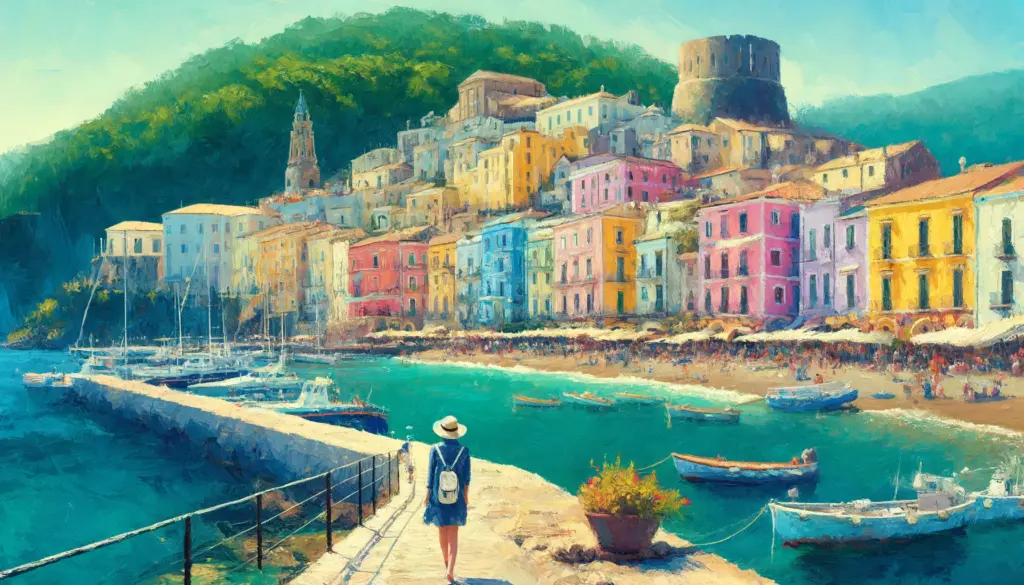ChatGPT:Ischia is a volcanic island located in the Tyrrhenian Sea, off the coast of Naples, Italy. It’s the largest island in the Bay of Naples and is known for its natural beauty, including lush landscapes, sandy beaches, and thermal springs. The island has a rich history, with ancient Greek and Roman influences, and offers a blend of historical sites, such as the Aragonese Castle, and charming villages like Ischia Ponte and Forio.
Ischia is renowned for its thermal spas, thanks to its volcanic origins, making it a popular destination for wellness tourism.
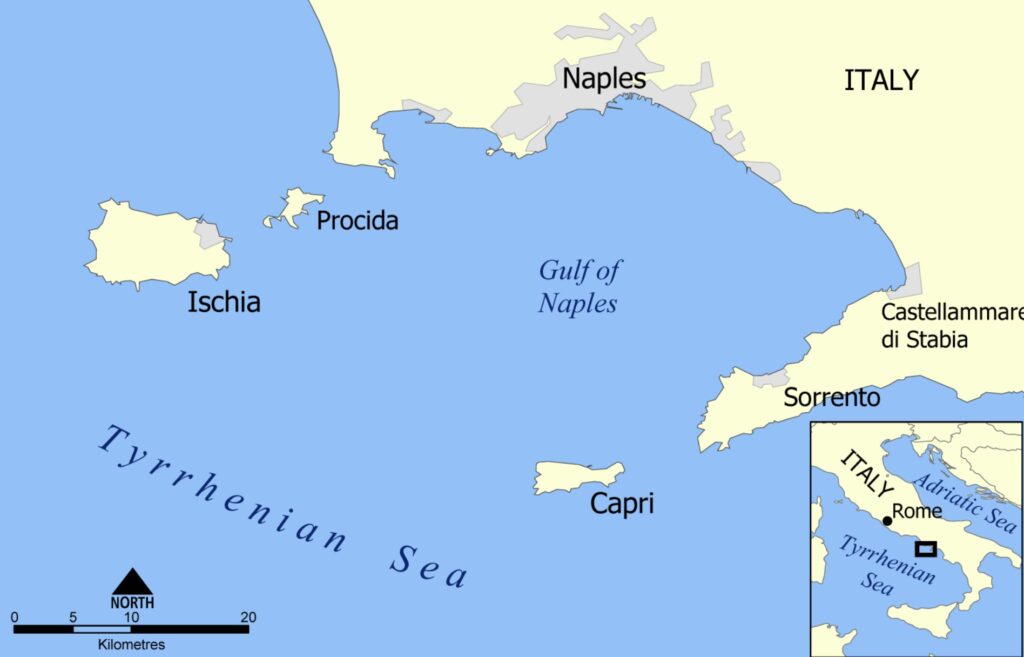
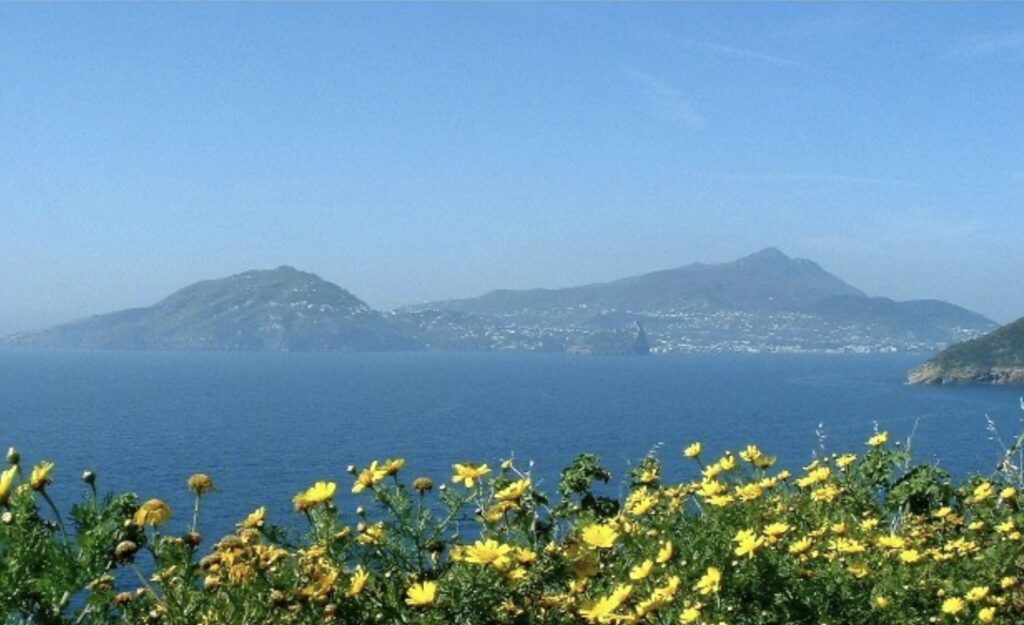
Ischia’s origins trace back to ancient times, with its geological formation as a volcanic island. It emerged from the Tyrrhenian Sea due to volcanic activity, which continues to influence its landscape, including the presence of hot springs and fumaroles.
Ancient History:
The earliest known inhabitants of Ischia were the Greeks, who settled there around the 8th century BCE. They named the island “Pithekoussai,” believed to refer to its pottery production or the abundance of pine trees. The island became an important trade and cultural hub in the region. The Greeks also introduced viticulture, making wine production a long-standing tradition on the island.
During Roman times, Ischia, known as “Aenaria,” was a popular retreat for the Roman elite. The island’s thermal waters were appreciated for their healing properties, and many villas and baths were constructed. However, frequent volcanic activity and seismic events made the settlement challenging.
Medieval and Renaissance Periods:
After the fall of the Roman Empire, Ischia faced invasions and periods of neglect. The island was controlled by various powers, including the Ostrogoths, Byzantines, and Lombards. In the Middle Ages, Ischia was a contested territory between the Normans, Angevins, and the Kingdom of Naples.
One of the most significant historical developments was the construction of the Aragonese Castle in the 15th century by Alfonso V of Aragon. The castle served as a refuge from pirate attacks and became a symbol of the island’s resilience.
Modern Development:
In the 18th and 19th centuries, Ischia became increasingly recognized for its thermal springs, attracting visitors seeking health treatments. This laid the foundation for its development as a tourist destination. The island’s economy began to shift from agriculture and fishing to tourism.
The 20th century saw further growth in tourism, with improvements in infrastructure and accommodations. Today, Ischia is a popular destination for both Italian and international tourists, known for its natural beauty, thermal spas, and rich cultural heritage.
Ischia’s development continues to balance tourism with the preservation of its natural and historical resources, maintaining its charm while accommodating modern visitors.
Ischia is home to several charming towns and villages, each with its own unique attractions and historical monuments. Here are some of the most interesting ones:
1. Ischia Porto and Ischia Ponte
- Ischia Porto: The main town and port area, bustling with shops, restaurants, and nightlife. It’s a central hub for arriving tourists.
- Ischia Ponte: The older part of Ischia, known for its medieval streets and the iconic Aragonese Castle, a fortress built on a rocky islet connected to the town by a causeway. The castle offers stunning views and houses historical exhibits.
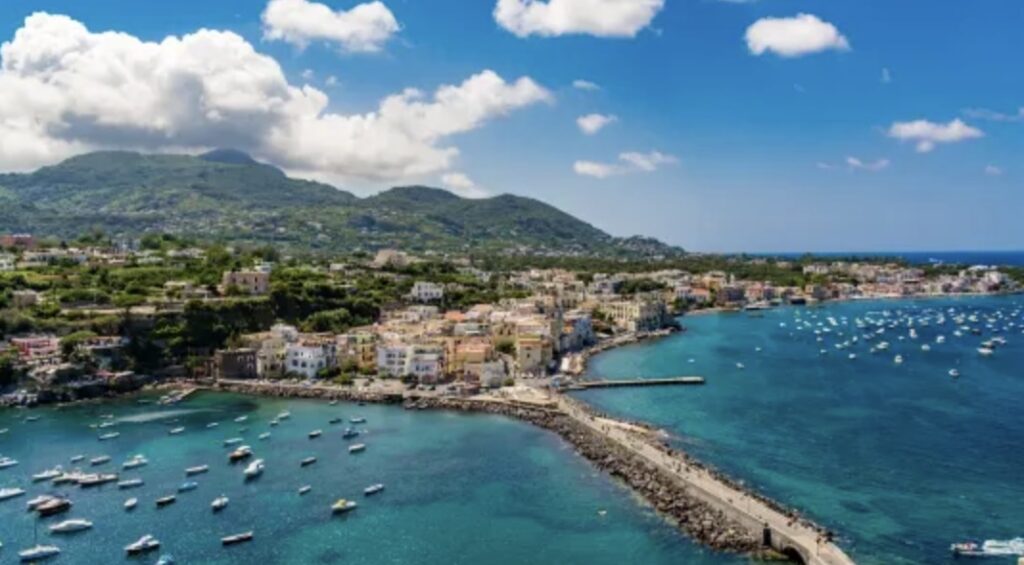
2. Forio
- Chiesa del Soccorso: A picturesque white church perched on a cliff overlooking the sea, known for its simple beauty and breathtaking sunsets.
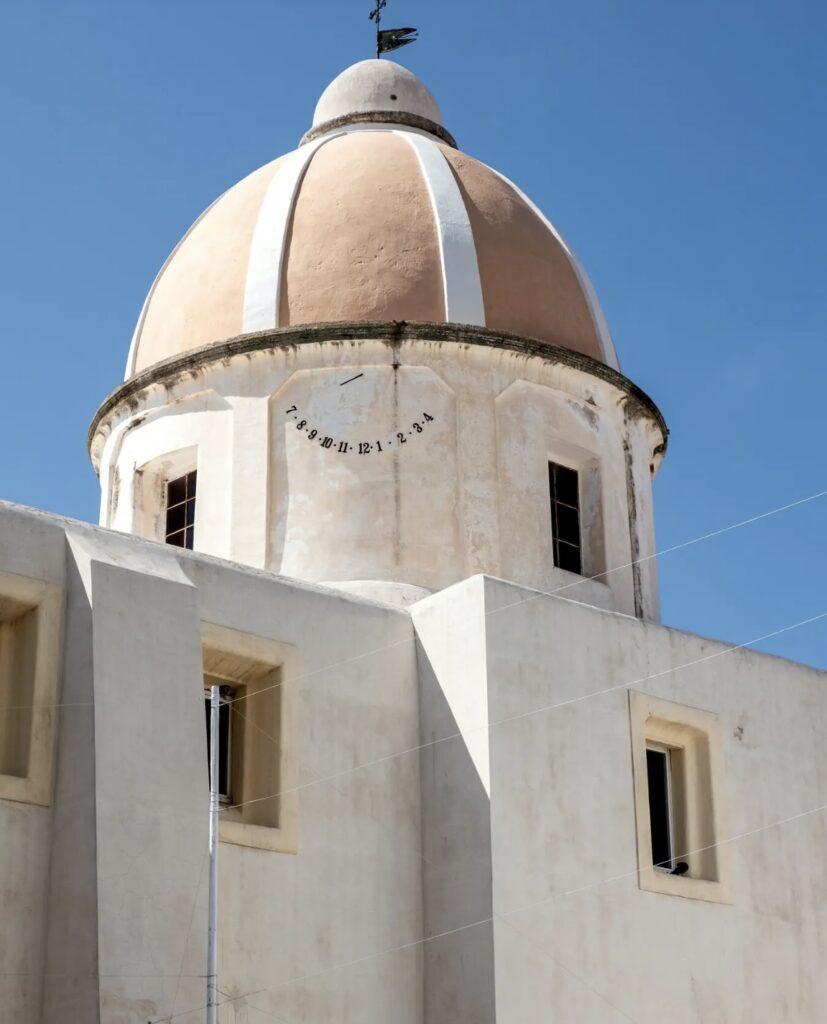
- La Mortella Gardens: A beautiful botanical garden created by Lady Susana Walton, featuring exotic plants, water features, and spectacular views.
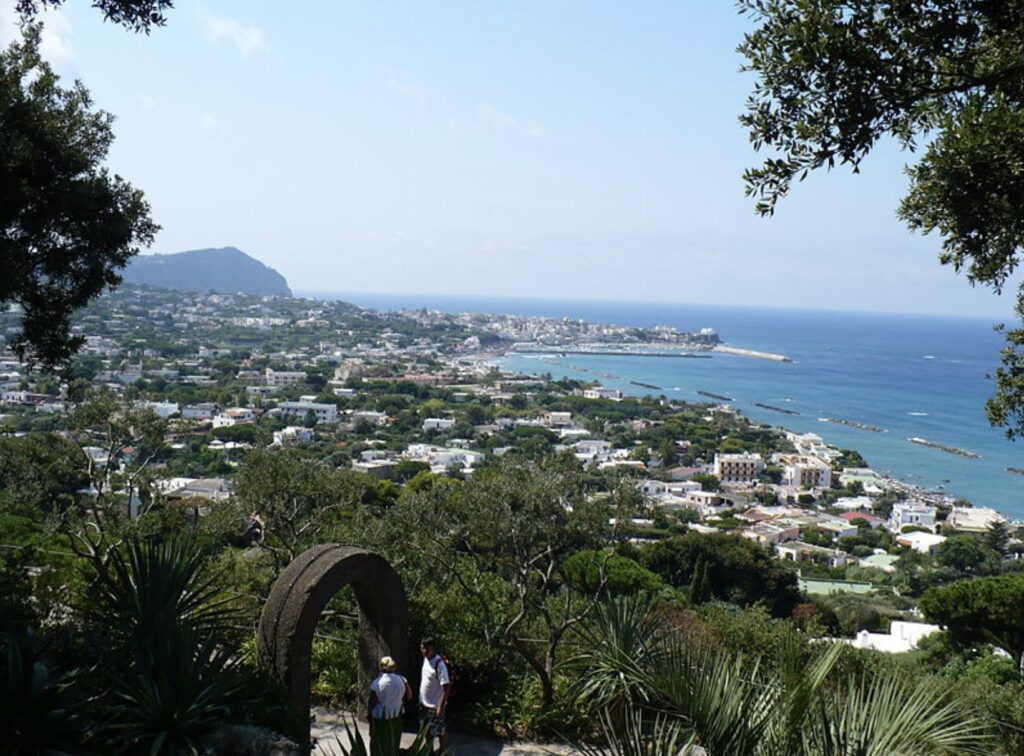
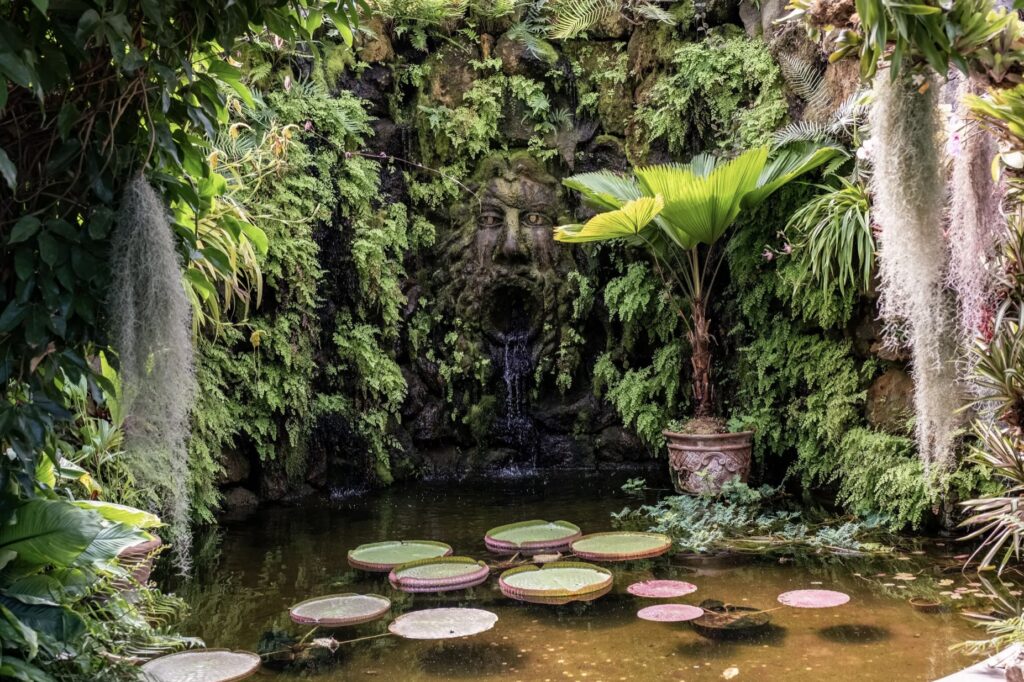
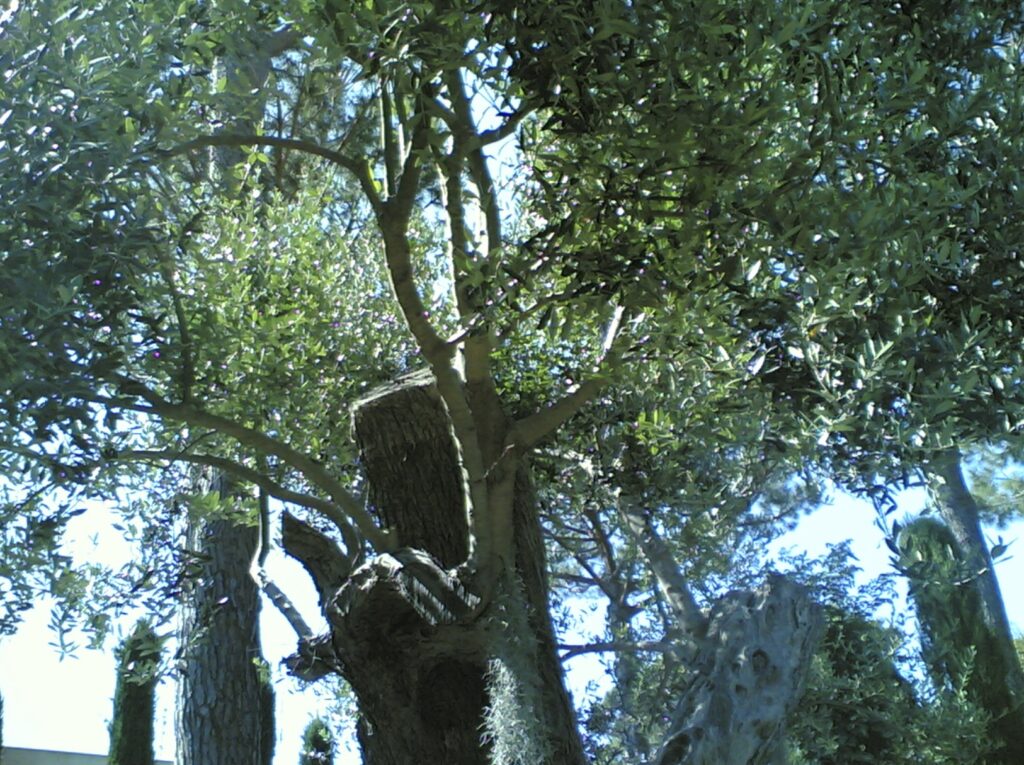
- Torrione: A historical tower that now houses a small museum and art gallery.
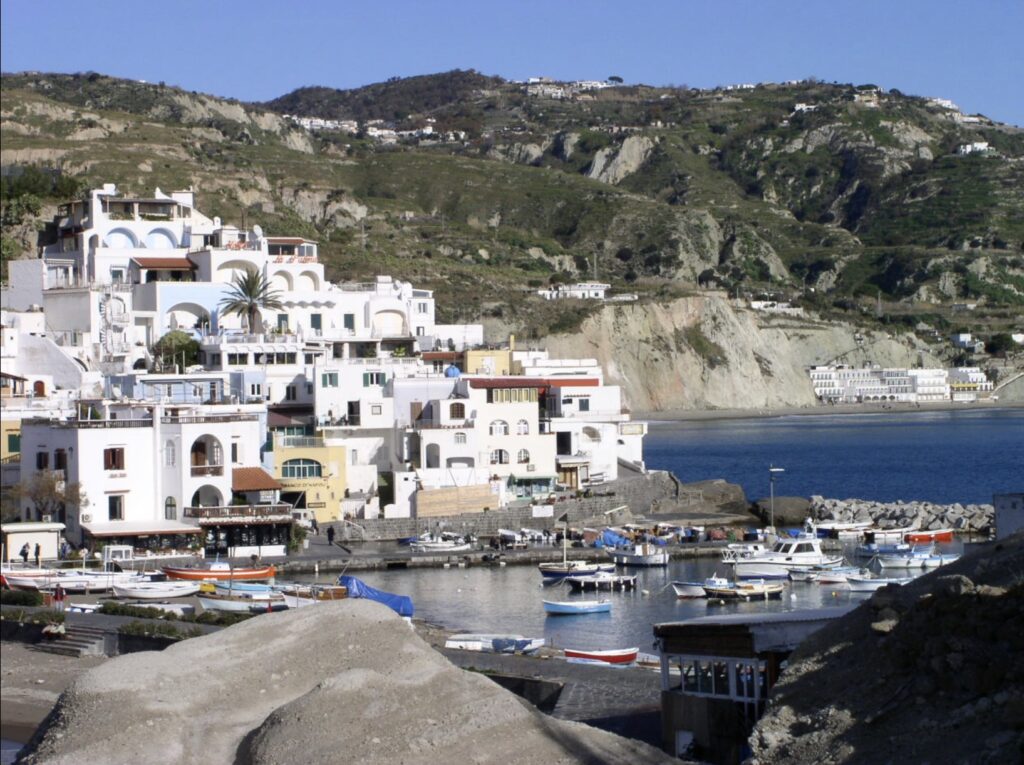
3. Lacco Ameno
- Museo Archeologico di Pithecusae: This museum exhibits artifacts from Ischia’s ancient Greek period, including pottery and other archaeological finds.
- Il Fungo: A distinctive mushroom-shaped rock formation in the sea, which is a symbol of Lacco Ameno.
- Villa Arbusto: An 18th-century villa housing the Archaeological Museum, offering insights into the island’s ancient past.
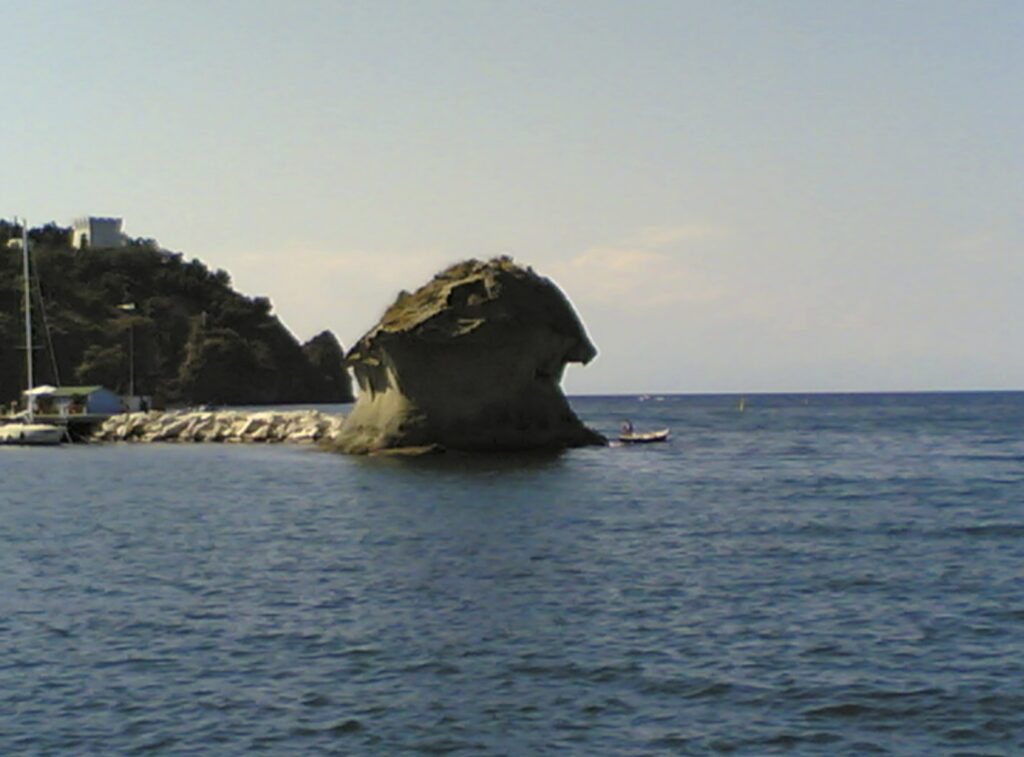
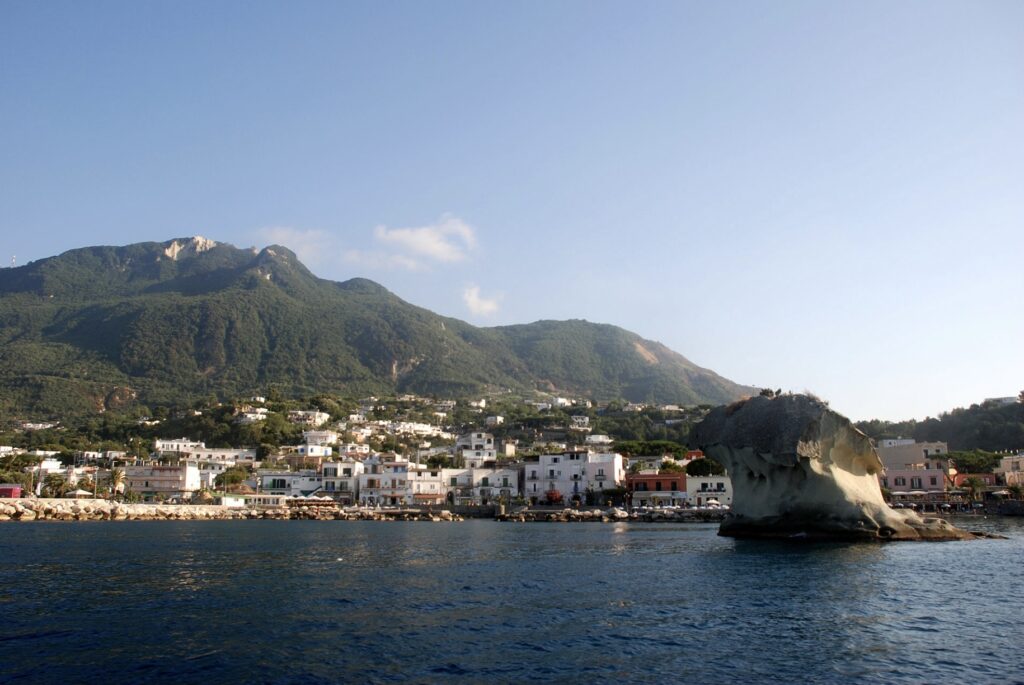
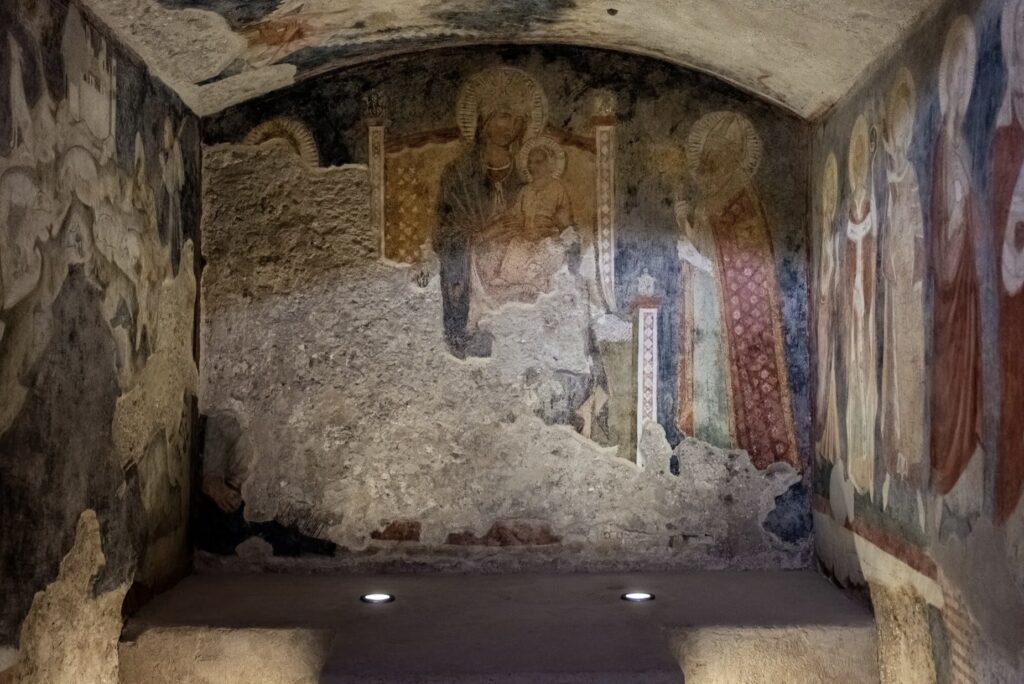
4. Casamicciola Terme
- Thermal Spas: Known for its hot springs and wellness resorts, Casamicciola Terme has been a spa destination since Roman times.
- Museo Angelo Rizzoli: A museum dedicated to the history of the famous Italian publisher and film producer who invested significantly in the development of the island.
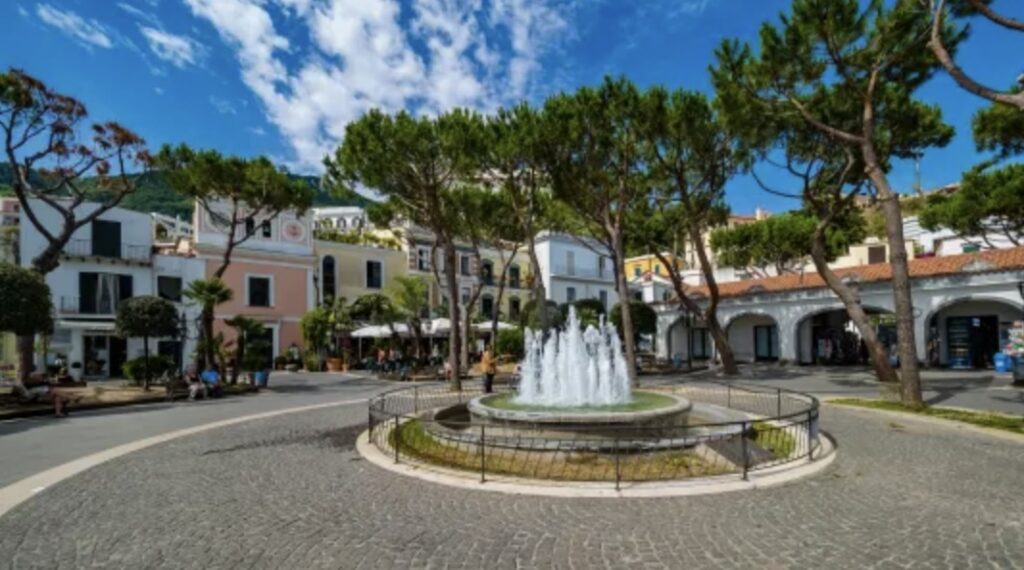
5. Serrara Fontana
- Monte Epomeo: The highest point on Ischia, offering panoramic views of the island and the Bay of Naples. The hike to the summit is a popular activity.
- Sant’Angelo: A picturesque fishing village within the municipality of Serrara Fontana, known for its charming narrow streets, colorful houses, and a scenic harbor.
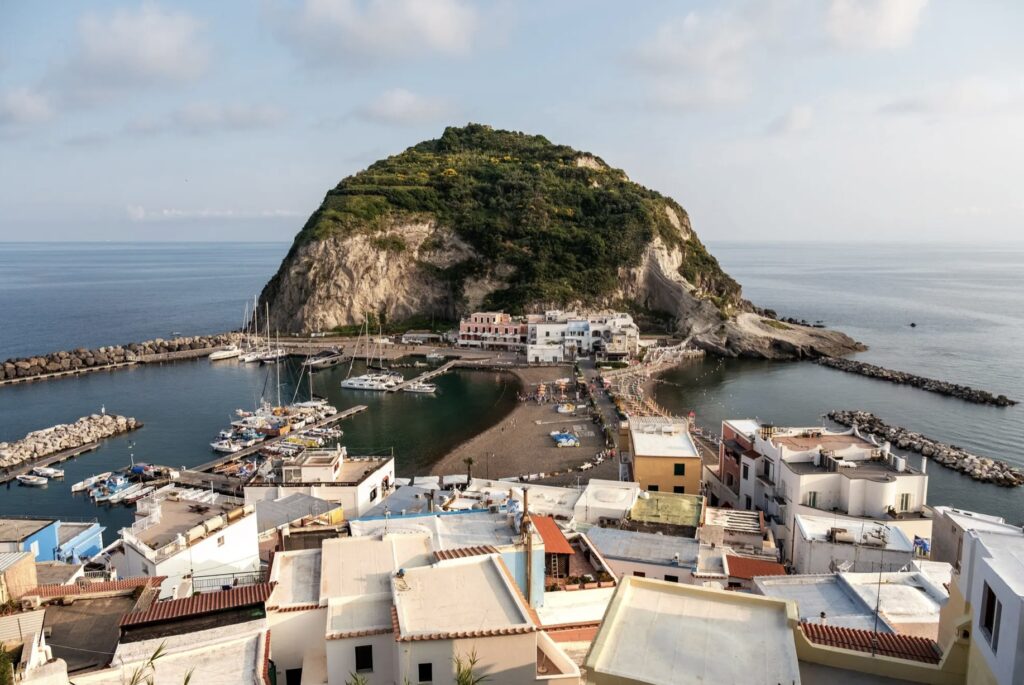
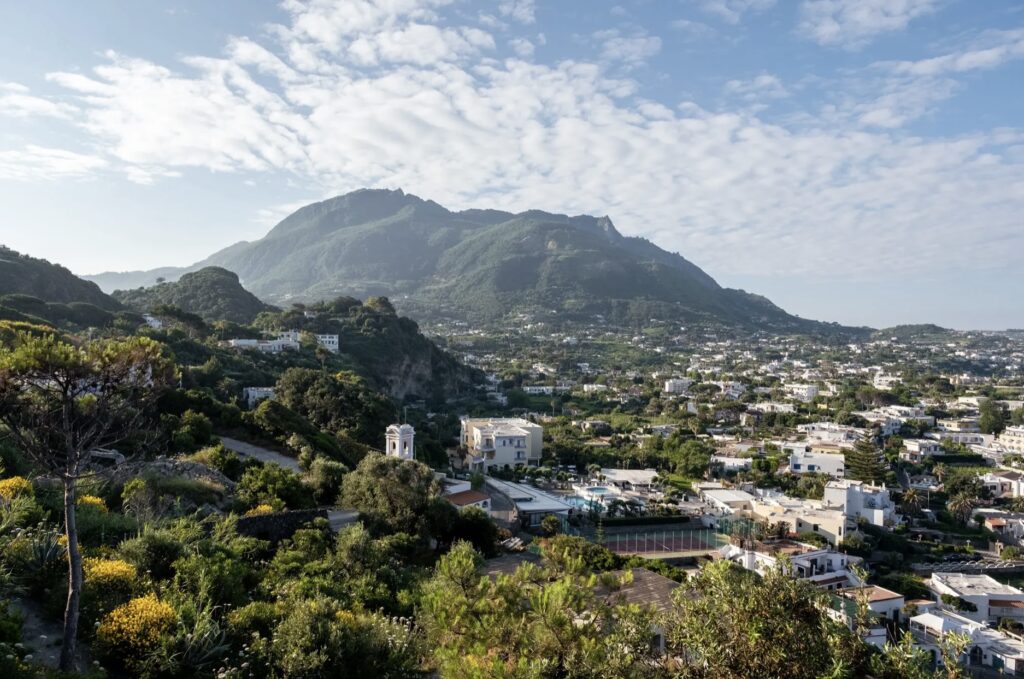
6. Barano d’Ischia
- Maronti Beach: One of the longest beaches on the island, famous for its hot sand and natural fumaroles. It’s a great spot for sunbathing and swimming.
- Olmitello and Nitrodi Springs: Known for their mineral-rich waters believed to have therapeutic properties.
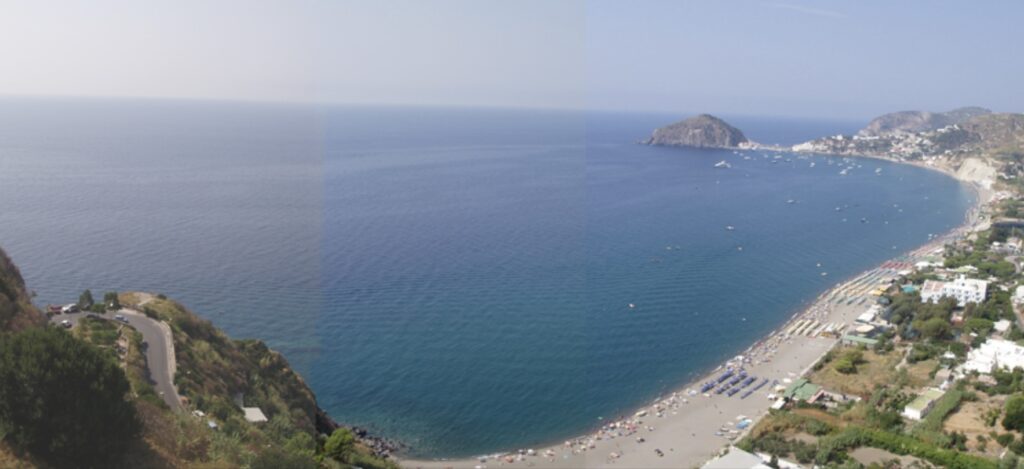
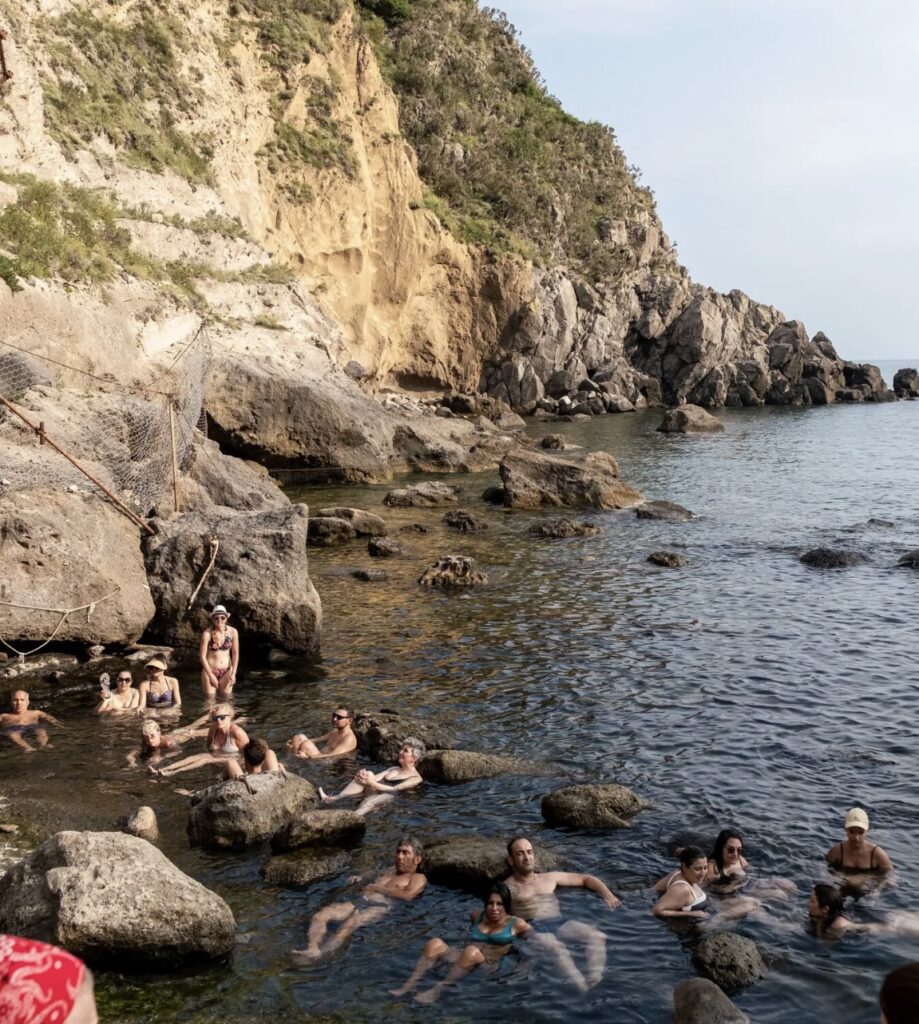
These towns and villages collectively offer a blend of natural beauty, cultural heritage, and leisure activities, making Ischia a diverse and appealing destination.
One of the most famous thermal parks in Ischia is the Poseidon Thermal Gardens (Giardini Poseidon Terme). Located in the Bay of Citara near the town of Forio, Poseidon Gardens is renowned for its extensive array of thermal pools and beautiful natural surroundings.
Poseidon Thermal Gardens Highlights:
- Thermal Pools: The park features over 20 thermal pools of varying temperatures, ranging from cool to hot, each fed by the island’s natural volcanic springs. The pools are designed for different therapeutic purposes, such as relaxation, circulation improvement, and detoxification.
- Wellness and Spa Services: In addition to the thermal baths, Poseidon offers a variety of wellness treatments, including massages, mud baths, and beauty treatments, making it a popular destination for those seeking relaxation and rejuvenation.
- Natural Setting: The gardens are beautifully landscaped with Mediterranean plants, flowers, and terraces that offer stunning views of the sea. The setting adds to the tranquility and appeal of the park.
- Beach Access: The park has direct access to the beach, allowing visitors to alternate between the thermal pools and the sea, which is a unique experience. The beach area is equipped with sunbeds and umbrellas for relaxation.
- Dining and Amenities: There are several restaurants and cafes within the park offering a variety of cuisines, from local Italian dishes to international options. The park is also equipped with changing rooms, showers, and other amenities to ensure a comfortable visit.
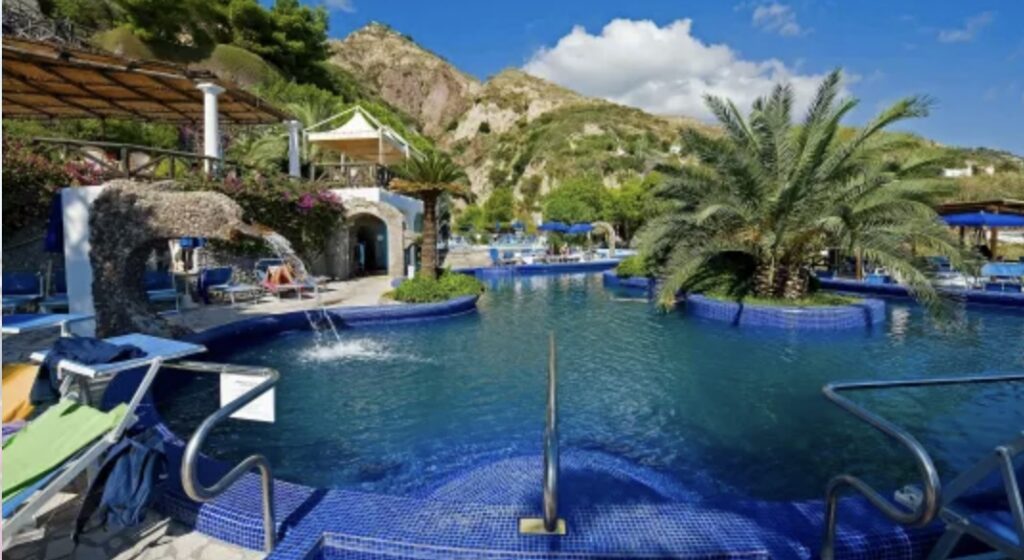
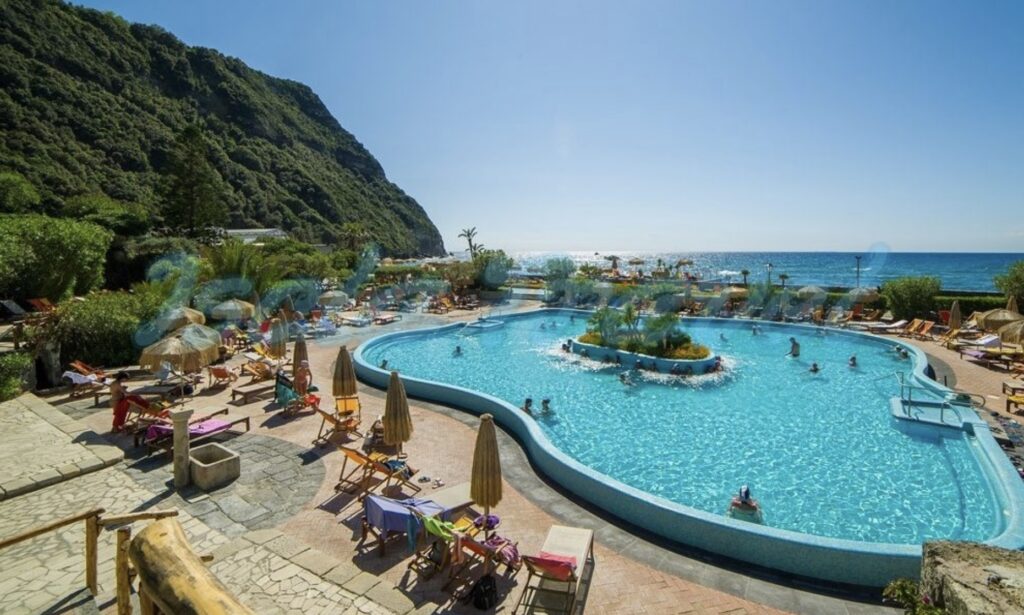
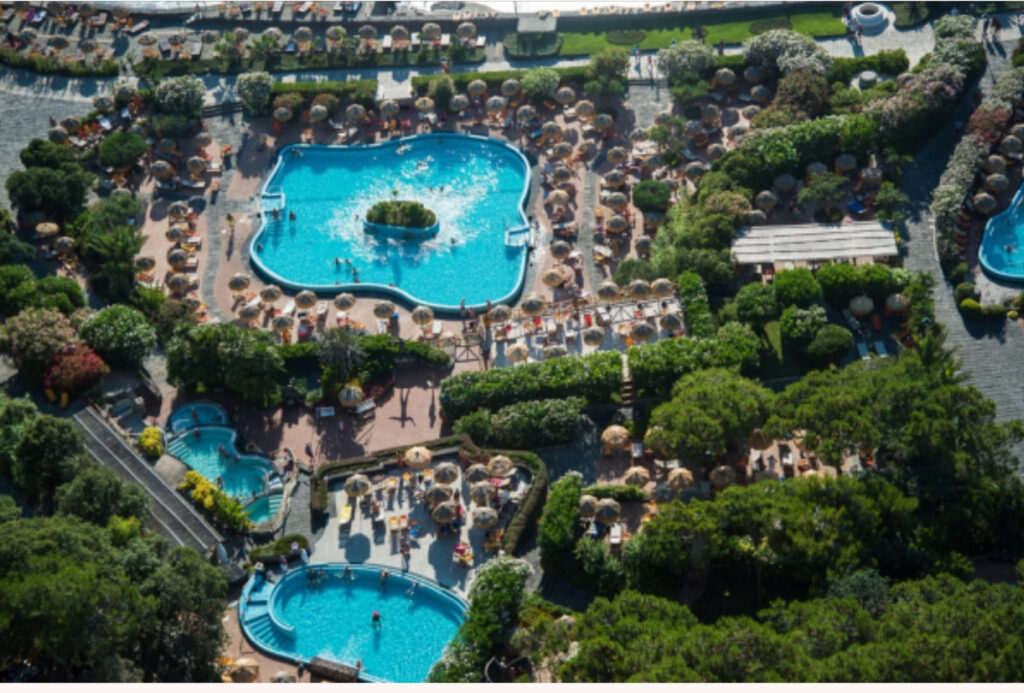
Ischia is home to several significant archaeological sites that reflect its rich historical and cultural heritage. One of the most notable is:
Museo Archeologico di Pithecusae (Archaeological Museum of Pithecusae)
Located in the town of Lacco Ameno, this museum is housed in the Villa Arbusto, an 18th-century villa. The museum’s collection focuses on the ancient Greek and Roman history of Ischia, showcasing artifacts discovered in the area. Highlights include:
• Nestor’s Cup: One of the most famous artifacts in the museum, this ancient Greek cup dates back to the 8th century BCE. It is inscribed with a Greek epigram and is considered one of the earliest examples of Greek writing. The inscription suggests that the cup was associated with the legendary hero Nestor from Homer’s “Iliad.”
• Pottery and Ceramics: The museum displays a wide range of ancient pottery, including beautifully decorated vases, amphorae, and other ceramics. These items provide insight into the daily life, trade, and artistic expressions of the island’s ancient inhabitants.
• Bronze and Metal Artifacts: The museum also features a collection of bronze and metal objects, such as tools, weapons, and jewelry, which offer a glimpse into the technological and cultural practices of ancient societies.
• Terracotta Figurines and Statues: The museum’s collection includes terracotta figurines and statues, some of which depict deities, mythological figures, and scenes from daily life.Other Notable Sites:
1. Aragonese Castle: While primarily known as a fortress, the Aragonese Castle also contains remnants of ancient settlements and structures, providing insights into Ischia’s medieval and earlier history.
2. Monte Vico: Near Lacco Ameno, Monte Vico is an ancient acropolis site where archaeological excavations have uncovered Greek and Roman artifacts, including pottery, coins, and architectural remains.
3. Santa Restituta’s Crypt and Museum: Located in the town of Lacco Ameno, this site includes a church and a museum dedicated to Santa Restituta, the patron saint of Ischia. Archaeological excavations here have revealed early Christian artifacts and relics.These archaeological sites offer valuable insights into Ischia’s ancient past, making the island a fascinating destination for history enthusiasts and those interested in archaeology.
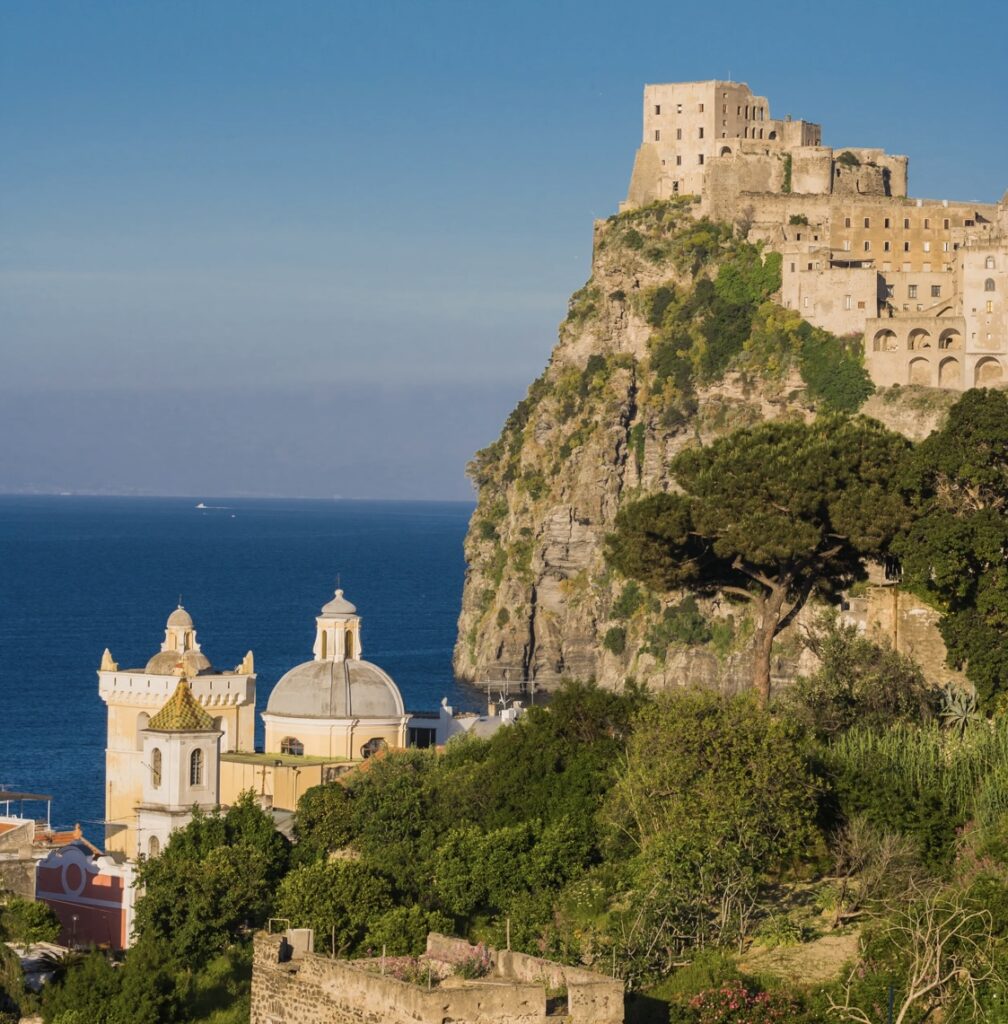
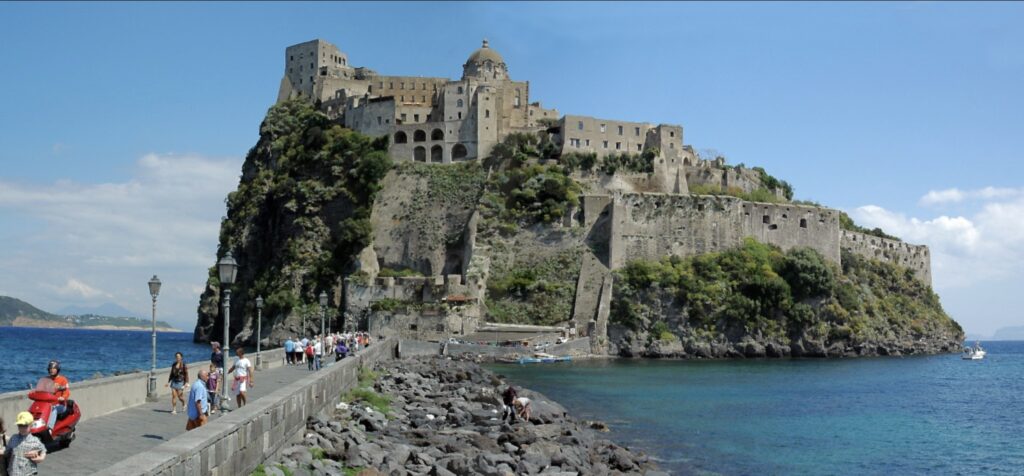
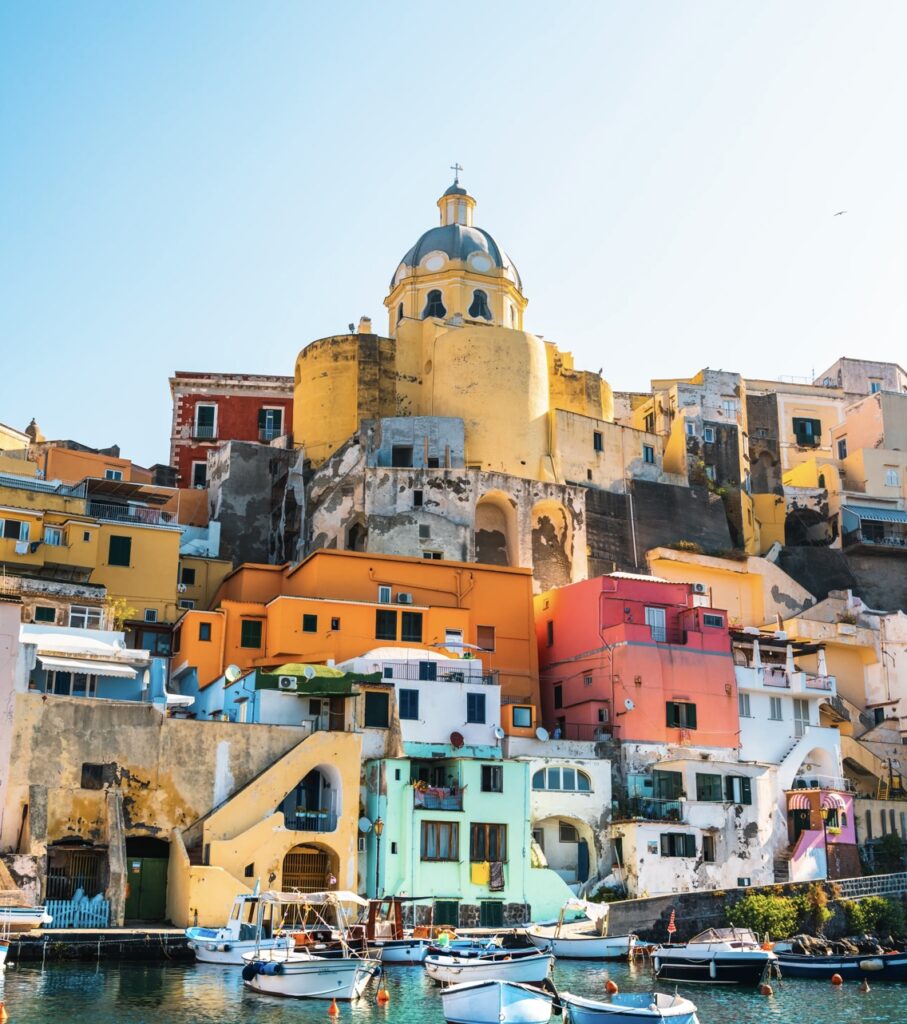
Traveling to Ischia from the mainland of Italy is typically done via ferry or hydrofoil from Naples, as Ischia is an island in the Tyrrhenian Sea. Here are the main steps to get to Ischia:
1. Reach Naples:
- By Air: The nearest airport is Naples International Airport (Aeroporto di Napoli-Capodichino). From the airport, you can take a taxi, a bus, or the Alibus airport shuttle to reach the port.
- By Train: Naples has excellent rail connections with other major cities in Italy. The main train station, Napoli Centrale, is connected to the port area via a short taxi ride or the metro.
2. From Naples to Ischia:
- Ferries and Hydrofoils: There are two main ports in Naples that offer regular ferry and hydrofoil services to Ischia:
- Porto di Napoli (Molo Beverello): This is the main port for hydrofoils, which are faster but more expensive. The journey typically takes about 50 minutes to 1 hour.
- Calata Porta di Massa: This port services both ferries and hydrofoils. Ferries are slower but cheaper, taking about 1.5 to 2 hours. Ferries are a good option if you’re traveling with a car, as they have vehicle transport facilities.
- Tickets: It’s advisable to book tickets in advance, especially during the peak tourist season (summer months), weekends, and holidays. Tickets can be purchased online, at the port, or through travel agencies.
3. Arriving on Ischia:
- Ports on Ischia: The island has several ports where ferries and hydrofoils arrive, including Ischia Porto, Casamicciola Terme, and Forio. Ischia Porto is the main and busiest port, located close to the town center and offering numerous amenities.
4. Onward Travel on Ischia:
- Taxis and Buses: Once on the island, taxis and buses are available to transport you to your accommodation or other parts of the island. Public buses are a convenient and cost-effective way to get around Ischia, with routes connecting the main towns and attractions.
- Car or Scooter Rentals: Renting a car or scooter is another popular option for exploring the island, providing flexibility to visit different towns, beaches, and thermal parks at your own pace.
Ischia is well-connected and accessible, making it easy to visit from the mainland of Italy, particularly from Naples.
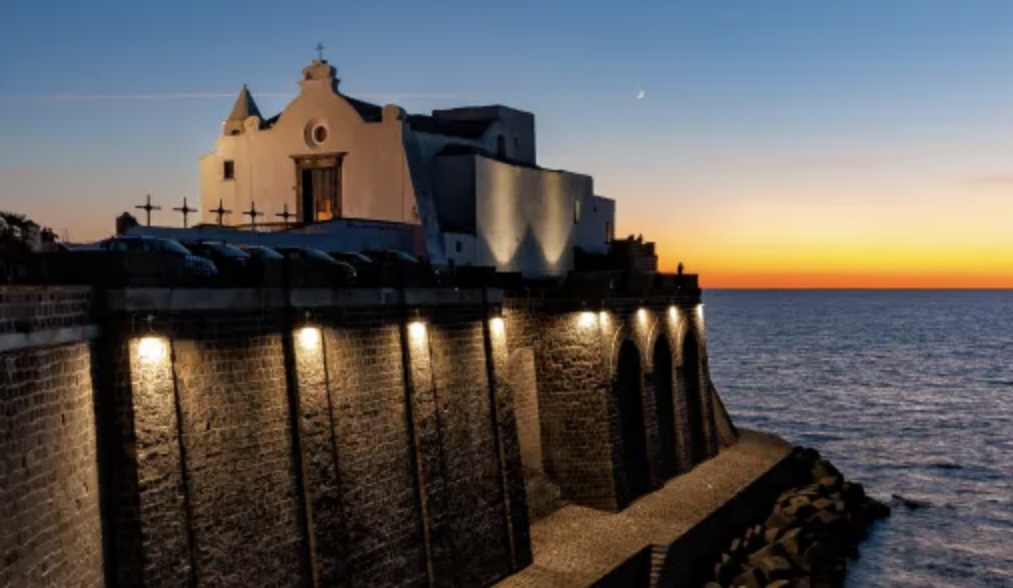
Here’s a three-day itinerary for visiting Ischia, combining visits to thermal springs, archaeological sites, and local culinary experiences, along with a recommendation for a five-star accommodation.
Day 1: Arrival and Historical Exploration
Morning:
- Arrival and Check-In: Check into the San Montano Resort & Spa, a luxurious five-star hotel located in Lacco Ameno. The resort offers stunning views, top-notch amenities, and easy access to the island’s attractions.
- Ischia Porto: Start your journey in Ischia Porto, the island’s main hub. Explore the local shops and enjoy a morning coffee at a café overlooking the harbor.
Lunch:
- Local Cuisine: Savor a traditional Ischian lunch at a local trattoria. Try “Coniglio all’Ischitana” (Ischian-style rabbit) or “Gnocchi alla Sorrentina” (potato gnocchi with tomato sauce and mozzarella).
Afternoon:
- Aragonese Castle: Visit the iconic Aragonese Castle in Ischia Ponte. Explore its historical structures, chapels, and museums, and enjoy panoramic views of the island and the sea.
Evening:
- Dinner: Enjoy dinner at a seaside restaurant in Ischia Ponte. Try fresh seafood dishes like “Spaghetti alle Vongole” (spaghetti with clams) or “Pesce al Sale” (salt-crusted fish).
Day 2: Thermal Springs and Archaeological Exploration
Morning:
- Poseidon Thermal Gardens: Spend the morning relaxing at Poseidon Thermal Gardens in Forio. Enjoy the various thermal pools, spa treatments, and the beautiful Mediterranean garden setting.
Lunch:
- On-site Dining: Have lunch at one of Poseidon’s restaurants, which offer a range of Italian and Mediterranean dishes made with fresh local ingredients.
Afternoon:
- Museo Archeologico di Pithecusae: Visit the Archaeological Museum of Pithecusae in Lacco Ameno. Explore its extensive collection of ancient Greek and Roman artifacts, including the famous Nestor’s Cup.
Evening:
- Dinner: Dine at a local restaurant in Lacco Ameno, enjoying dishes such as “Totani e Patate” (squid and potato stew) or “Frittura di Paranza” (mixed fried fish).
Day 3: Sant’Angelo and Natural Springs
Morning:
- Sant’Angelo: Visit the charming village of Sant’Angelo. Stroll through its narrow, picturesque streets, visit boutique shops, and relax by the serene harbor.
Lunch:
- Seaside Lunch: Enjoy a leisurely lunch at a restaurant in Sant’Angelo, sampling dishes like “Insalata di Polpo” (octopus salad) or “Impepata di Cozze” (peppered mussels).
Afternoon:
- Fumarole Beach and Cavascura Baths: Experience the natural thermal springs at Fumarole Beach, where you can dig into the hot sand heated by volcanic activity. Then, visit the nearby Cavascura Thermal Baths for a natural spa experience with hot spring pools and therapeutic mud treatments.
Evening:
- Farewell Dinner: Enjoy a farewell dinner at the hotel’s fine dining restaurant, indulging in gourmet dishes paired with local wines. End your trip with a sunset view from the resort’s terrace.
Accommodation Recommendation:
- San Montano Resort & Spa: This five-star resort offers luxurious accommodations, multiple pools, a spa, and excellent dining options. The resort’s location provides stunning views of the Gulf of Naples and easy access to many of Ischia’s attractions.
This itinerary provides a well-rounded experience of Ischia, combining relaxation at thermal springs, exploration of historical and archaeological sites, and delightful local culinary experiences.
